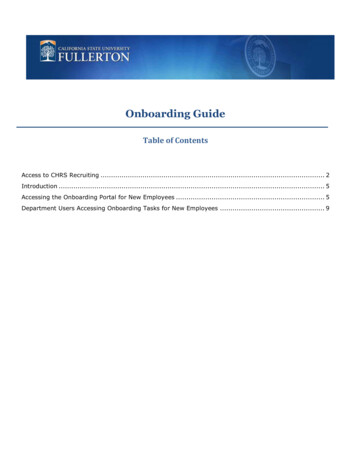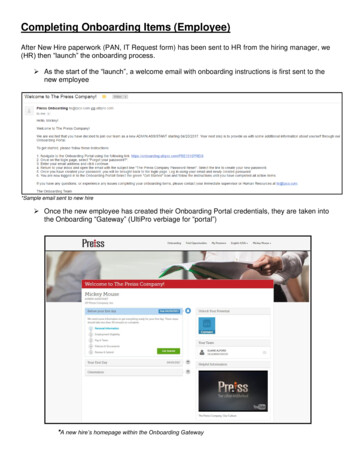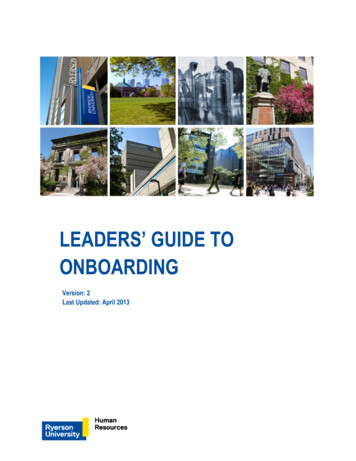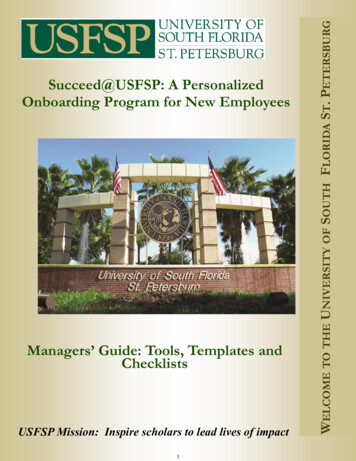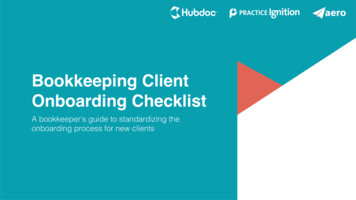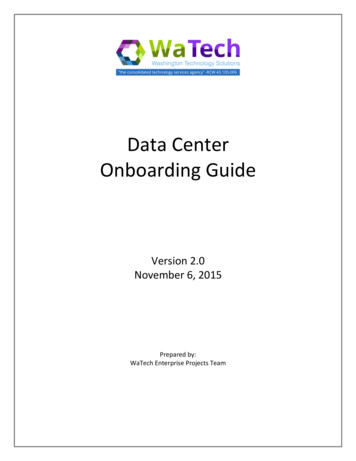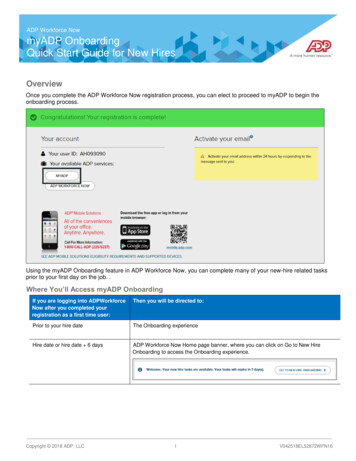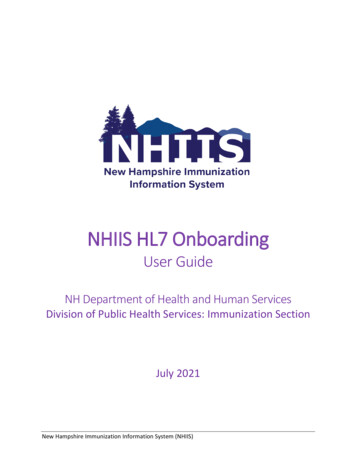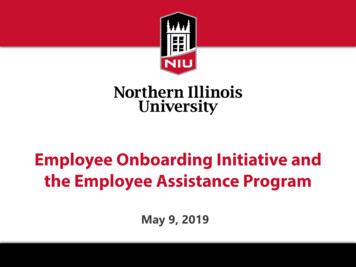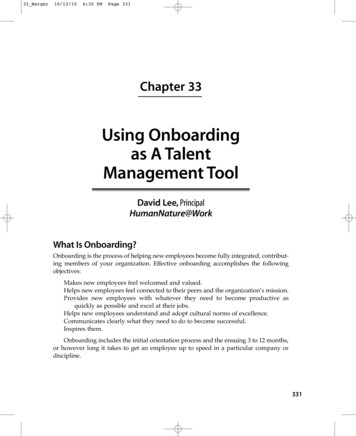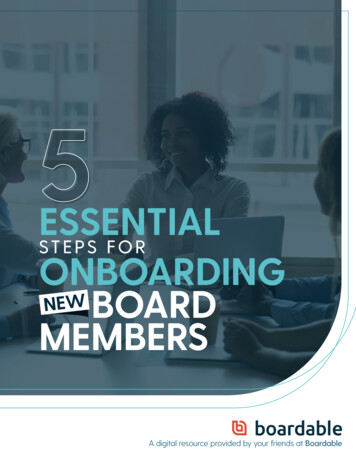
Transcription
5ESSENTIALSTEPS FORONBOARDINGNEW BOARDMEMBERSA digital resource provided by your friends at Boardable
INDEX Introduction 03 Onboarding Starts withRecruitment 04 Step 1: Develop an OnboardingFramework 05 Step 2: Determine WhichTeam Members OwnOnboarding 07 Step 3: Collect andOrganize OnboardingContent 08 Step 4: Engage New BoardMembers 10 Step 5: Continually Revisitthe OnboardingProcess 11 Board Manual Checklist 13 Conclusion 15Board Management — SimplifiedNew Board Member Onboarding 02
IntroductionWhen someone commits to board service, they agree to accept a lot of responsibility for theorganization They’re tasked with making strategic decisions that drive long-term financialsuccess for the mission — often on a strict timeline With as much as they’re responsible for, thereare countless points along the road where boards can veer off in the wrong direction Many times, boards of directors are derailed due to nothing more than confusion or uncertainty,which can happen when board members don’t understand the expectations, goals, or evenbasic processes of the boards they’re joining They see board service as a way to give back totheir community but don’t always know what that commitment entails Then, when issues orquestions arise, even the most thorough handbooks can’t account for every contingency That’s why effective onboarding is so vital for boards — particularly volunteer boards wherenot everyone has prior experience in the sector Onboarding helps get everyone on the samepage regarding the organization’s policies and what day-to-day duties will look like.While it’s clear that brand new boards should have steps in place to welcome new members,well-established organizations need to frequently revisit their onboarding processes, too Itdoesn’t matter if your board was established several years ago or you’re starting from scratch— best practices are always changing, more boards are becoming remote or hybrid, andorganizations are constantly finding better ways to bring their boards up to speed This e-book will delve into the 5 easy (yet often overlooked) steps organizations can take toprepare their board members, whether in person or remote, for successful terms We’ll evenshare a convenient checklist for building out a new board member manual It’s time to create amuch more welcoming environment for board members from before they ever even step in theboardroom!Board Management — SimplifiedNew Board Member Onboarding 03
Onboarding Starts WithRecruitmentContrary to popular belief, onboarding doesn’t start the moment a new board member walks inthe room It doesn’t even start when you send a “Welcome Aboard” email It starts in the earlyrecruitment stages where you’re communicating expectations and figuring out if they’ll be agood fit It’s no small feat to find the right combination of creativity and enthusiasm in prospective boardmembers Will they mesh well with your current board members? It’s a gamble!When you’re recruiting new board members and finding people who will be assets to theorganization, be sure to address the following attributes:1.Mediation Skills: Board service is a masterclass in compromise Newboard members might feel overpowered by other members who havebeen there longer or who have assumed leadership or spokesperson roleson the team Look for candidates who are willing to listen to those whohave board experience, while also knowing when to speak up when theyhave something of value to add Finding veteran board members whoare willing to mentor new people virtually or in person can be helpful indeveloping mediation skills, too 2.Fundraising Skills: While fundraising might not be the number one thingthat board members handle, they definitely play an important role indevelopment When creating an application or posting an announcementfor new board members, point out fundraising skills as a requirement 3. Expectations and Goals: Because board members are volunteers andmight not have prior sector experience, many board members are oftenunaware of the actual responsibilities associated with the day-to-daywork of serving on a board However, finding the right people to lead anorganization is critical to its sustainability Take time during the application,interview, and onboarding process to make sure you’re completelytransparent with candidates about expectations, individual members’roles, and how success will be measured Board Management — SimplifiedNew Board Member Onboarding 04
Step 1: Develop anOnboarding FrameworkWhen new board members start, it can be tempting to jump in feet first, get them set up oncommittees, and have them start making decisions right away You want to put their skills towork as soon as possible, but this doesn’t give them any time to get acclimated!Instead, boards should have an onboarding framework that is replicable and scalable. Nomatter when they join, every single new board member should hear the same message, learnthe same processes, and experience the same lessons This will help alleviate any confusion oruncertainty down the road The framework should be created within a collaborative, thoughtfulprocess that considers multiple perspectives Board Management — SimplifiedNew Board Member Onboarding 05
No matter your mission, a strategic onboarding framework should include: A broad, inclusive approach to the mission and values of the organization. What areboard members trying to achieve? Input from current board members. What would have made their early days on theboard better? What would have made them more productive? A detailed description of all committees. What kinds of decisions and programs areeach committee responsible for? A section for ongoing education and development. How will the new board membercontinue to grow and develop within the board?Having a framework that accounts for these core elements with each new class of directors youbring in will make sure everyone’s on the same page, no matter when they join Not to mention,a scalable structure ensures that your onboarding process can grow as your organization does No need to start from scratch when you have a solid foundation in place You’ll be able to simplyupdate your onboarding resources with information regarding new committees, changingorganizational goals, responsibilities, and guidance from the most recent board members Board Management — SimplifiedNew Board Member Onboarding 06
Step 2: Determine WhichTeam Members OwnOnboardingIn the most efficient and well-organized boardrooms — whether online or in a physical space— every single person has a unique role that allows the board to operate like a mini corporationof its own Just like big companies have a team that’s dedicated to managing onboarding, soshould your board Depending on the size of your team, either appoint a single person orestablish a committee to handle all things onboarding.With one committee that owns onboarding, there should be minimal overlap between teams This group should be responsible for gathering the correct information and documentation from: All the other committees The organization’s staff Any third-party thought leadersThis will also give new board members an important resource to go to with any questions,concerns, or inquiries instead of having to hunt down several different people from differentteams Board Management — SimplifiedNew Board Member Onboarding 07
Step 3: Collect andOrganize OnboardingContentIf you’ve worked in the sector for a while, it shouldn’t come as a surprise that boards require andmanage an incredible amount of content and information This is especially true for new boardmembers, who should have access to all of this critical content and additional onboardingdocuments This is where the board book enters the conversation Typically, whoever owns onboarding isresponsible for collecting and organizing all components of a board manual Board Management — SimplifiedNew Board Member Onboarding 08
STAFF DIRECTORYBOARD MEMBER DIRECTORYORGANIZATIONAL PROGRAMSHISTORY ONE-PAGERSomecommonresourcesinclude thefollowing:LOGISTICS & POLICY INFORMATIONORGANIZATION & OPERATIONAL GUIDELINESSTRATEGIC FRAMEWORK OF THE ORGANIZATIONBOARD & INDIVIDUAL RESPONSIBILITIESA LIST OF COMMITTEES & THEIR CHARGESMEETING MINUTES & REPORTSFINANCE & FUNDRAISING OVERVIEWSUPPLEMENTAL INFORMATION & APPENDIXGet a complete checklist of everything you need to complete your board book on page 14 Want to delve into the wonderful world of effective documentation as you reinvent your boardmanual? Why It’s Time for Modern Boards To Blow Up the Board Book is another resourcecreated by the board management experts here at Boardable It reimagines the traditionalapproach to board books and takes a closer look at what information you should include aswell as how you can make it completely accessible to board members No need for a messyonboarding experience when you have an organized board book that’s easily adaptable andaccessible to new board members Board Management — SimplifiedNew Board Member Onboarding 09
Step 4: Engage NewBoard MembersIn many cases, new board members are elected to serve on a board by the current members,so they’ve met each other already Regardless, once a new board member has been broughtin and been sent the board manual, it’s time to kickstart their engagement with other boardmembers Introducing new board members to current board members can be done through:1. Social Events or Gatherings: Even before new board members step foot inthe boardroom, you might want to host an informal, virtual social gathering This way, your new board members will get to know their peers on a sociallevel, which can help ease any wariness or discomfort before the firstmeeting 2. Committee Roundtables: If your committees meet on days outside of yournormal board schedule, have the new members attend these to observe New board members should attend committee meetings for all committees,not just the ones they will be a part of This gives them an inside look athow each committee is run, how it arrives at decisions, and how differentteam members work together They’ll come to understand how theircommittee duties align with others’ 3. Board Meeting Introductions: And finally, the big day arrives: the newboard members’ first board meeting! Instead of kicking things off like anyother meeting, take a moment to introduce your new members to thegroup Have everyone else go around and introduce themselves along withthe positions they hold on the board Give new members a chance to sharea little about themselves along with an explanation of the connection theyhave with the organization Board Management — SimplifiedNew Board Member Onboarding 10
Step 5: ContinuallyRevisit the OnboardingProcessNo matter your industry, board work is never complete! There are always new processes, ideas,and procedures that can be implemented to build a more seamless, productive organization This is why metrics, feedback, and transparency are all so critical As someone who’s in charge of the board’s efficiency, you should provide valuable trainingresources to your board members to help them continually develop new skills and grow in theirroles, which will ultimately help your entire organization be more successful Board Management — SimplifiedNew Board Member Onboarding 11
At no point in the process is trainingmore important than duringonboarding.Optimizing this process isn’t a one-person job Every new board member who comes throughyour doors will have feedback, suggestions, and ideas for the onboarding process This helpsyou tap into innovative perspectives and ideas that will keep advancing your team While growing boards must have a single scalable process to work from, it should not be staticby any means All feedback should be measured and weighed to determine whether or not itwill make your onboarding process stronger This includes asking questions like: What content do new board members receive? What content do they find valuable? How are new board members accessing your board manual and other onboardingdocuments? Hint: A digital documentation solution makes accessing materials much moreconvenient. What kinds of communication are being sent before new board members’ first meeting?What about communication to other board members introducing new members? Can new board members confidently speak to the mission, vision, and goals of both theorganization and the board itself?Between asking these questions and any others you think of, consistently assessing andimproving your onboarding activities allows you to create a very valuable and welcomingprocess Not to mention, you won’t have to do a complete overhaul every few years if you’reconstantly updating your materials and strategies!Board Management — SimplifiedNew Board Member Onboarding 12
Board Manual ChecklistWe gave you a preview of what materials new board members should receive to make surethey’re adequately prepared to lead your organization Now, let’s go into a little more depth What exactly should go into a board manual for new-member orientation? Each organization isdifferent, but here are examples of information you could include to help you get started:Board Management — SimplifiedNew Board Member Onboarding 13
Staff & Programs List of all current staff members, including job titles and role descriptions Chart showing the structure of the organization Employee handbook, program descriptions, policies, and proceduresOrganizational Information Brief written history, fact sheet, or overview of the organization Articles of incorporation, bylaws, and IRS determination letter List of past board members and their rolesLogistics & Policy Information List of current board members’ names, contact information, bios, and roles within the board Board terms of all current board members Statement of responsibilities and expectations of board members Board meeting attendance policy Board member conflict of interest policy Miscellaneous documents, including pledge forms and insurance policies Operational calendar that’s updated annuallyOrganizational & Operational Guidelines Policy for recruiting, orienting, informing, and cultivating board members Succession guidelines and policy for unplanned board member exit Expectations and guidelines for board member performance evaluations Plan for interviewing and selecting a board chair Descriptions of different committees, task forces, or subcommitteesStrategic Framework of the Organization Mission and vision statement Strategic plan and roadmap of the organization Detailed action plan including objectives, responsibilities, timelines Ongoing status reports for the organizationMeeting Minutes & Reports A year’s worth of past board meeting minutes Reports and documentation from past committee meetings Any other reports, metrics, and minutes from the boardFinance & Fundraising Reports Financial reports for the organization, including prior annual report, most recent audit report,and current annual budget Financial forms required for the organization, including Form 990, banking resolutions, andinvestment policy Details around fundraising, including current donor list, fundraising plan and digital strategy,and a list of go-to fundraising sourcesMarketing Information & Supplemental Information Contact information, including the organization’s website and donation site Promotional materials such as marketing pages, branding guidelines, and messagingoverviews Guides for any tools or resources your team is using to manage board output Emergency contact info and communication planBoard Management — SimplifiedNew Board Member Onboarding 14
ConclusionOnboarding is a critical time foryour team It’s the first impressionthat new board members haveof your organization, and whetheror not the rest of their terms gowell depends heavily on theironboarding experience You shouldnaturally want to make the most ofevery moment!Remember, successful onboardingstarts with superior recruitment,which means you should thinkthrough how you’ll welcomepeople before they step foot in theboardroom for the first time Theyshould understand expectationsand know exactly the depth of thecommitment they’re making That’sthe only way you’ll wind up withpeople who will do everything theycan to lead your organization alongthe path of success Even once you put together acomprehensive board manual(with the help of Boardable’sDocument Center!) and immersivetraining opportunities, improvingyour onboarding process will bean ongoing priority That way, eachnew class of directors will be moreand more prepared In no time,you’ll start welcoming new boardmembers with open arms!Board Management — SimplifiedNew Board Member Onboarding 15
Are you ready to refineyour onboarding processesand maximize engagementin the boardroom?Launch a digital transformation withBoardable
About BoardableBuiltby Nonprofitfor Nonprofits.empowersyou toworkmoreAs leadersin the leaders,space, weunderstandBoardablethe frustrationyou Weknowthefrustrationyoufeelhours you lose) just from organizing board meetings — let alone staying(andthe hours you lose) just from organizing a meeting via email, phone, and text. We’veproductive and communicating between them via email, phone, and text lived it. We’re from the nonprofit world, too. After looking around for the right toolWe’vethatreality After totirelesslytheright solutionbutthatbutnot livedfindingit, wedecidedbuild it.searchingBoardableforis asoftwareplatformnot findingallit,communicationwe decided tobetweenbuild it ourselves!centralizesyou and your board. Find the best meetingtimes, securely store all of your documents, archive discussion threads and more—allBoardableinone place.is an online board management portal that centralizescommunication, secure document storage, meeting planning, andFor more information, to schedule a demo, or to try Boardable for free (no crediteverything involved with running a board of directors Founded in 2016 bycard or commitment), visit us at boardable.com.nonprofit leaders and founders, Boardable has a mission to improve boardengagement for nonprofits Boardable is based in Indianapolis, Indiana Learn more at www.boardable.com Copyright 20222020 BoardBoard Management Software,CopyrightSoftware, Inc.Inc AllAll rightsrights reserved.reserved Any reproduction, modification, distribution, transmission, publication, translation, display,hosting or sale of all or any portion of the contents of this document is strictly prohibitedwithout written permission of an authorized representative of the publisher.Board Management — SimplifiedNew Board Member Onboarding 17
that board members handle, they deinitely play an important role in development When creating an application or posting an announcement for new board members, point out fundraising skills as a requirement 3. Expectations and Goals: Because board members are volunteers and might not have prior sector experience, many board members are often

